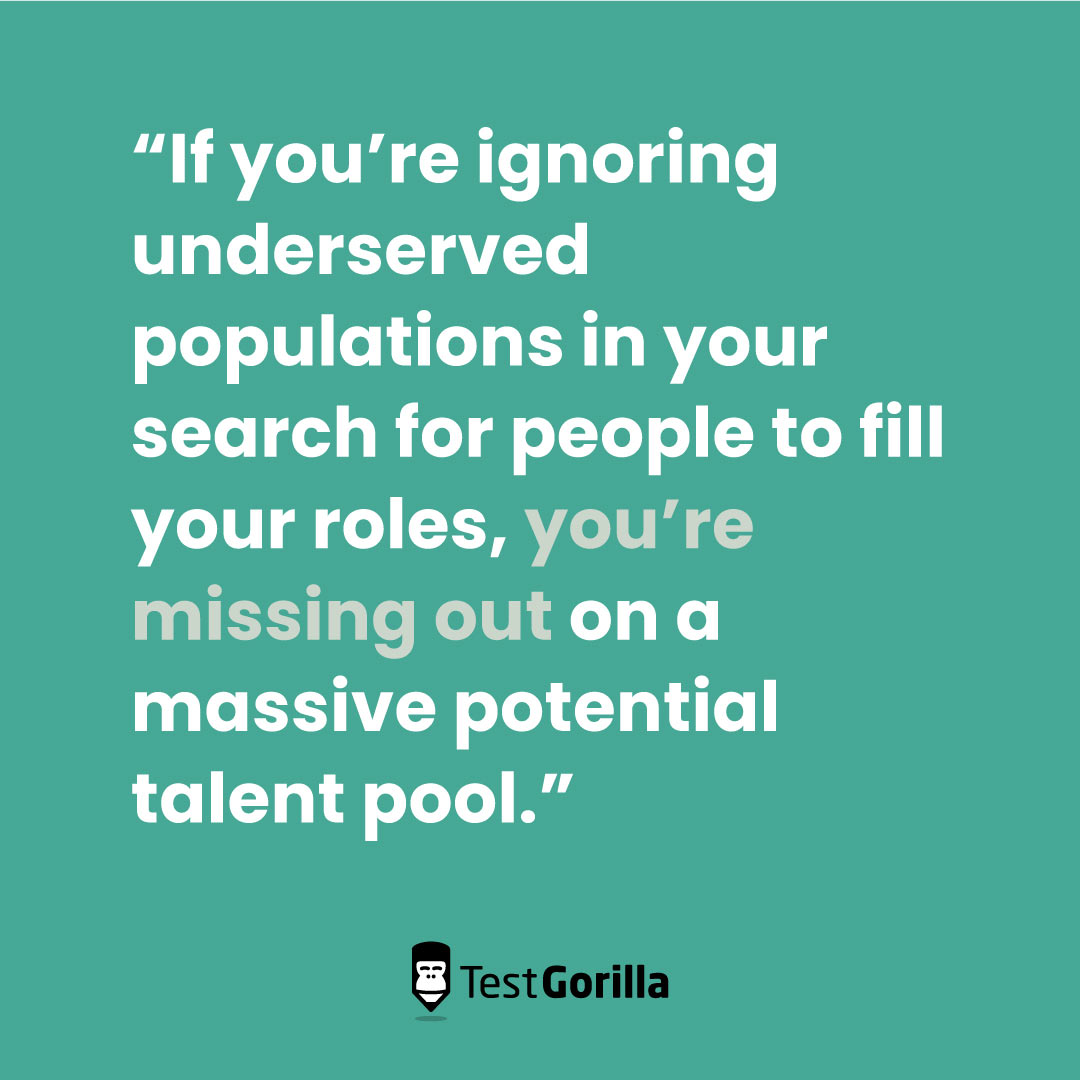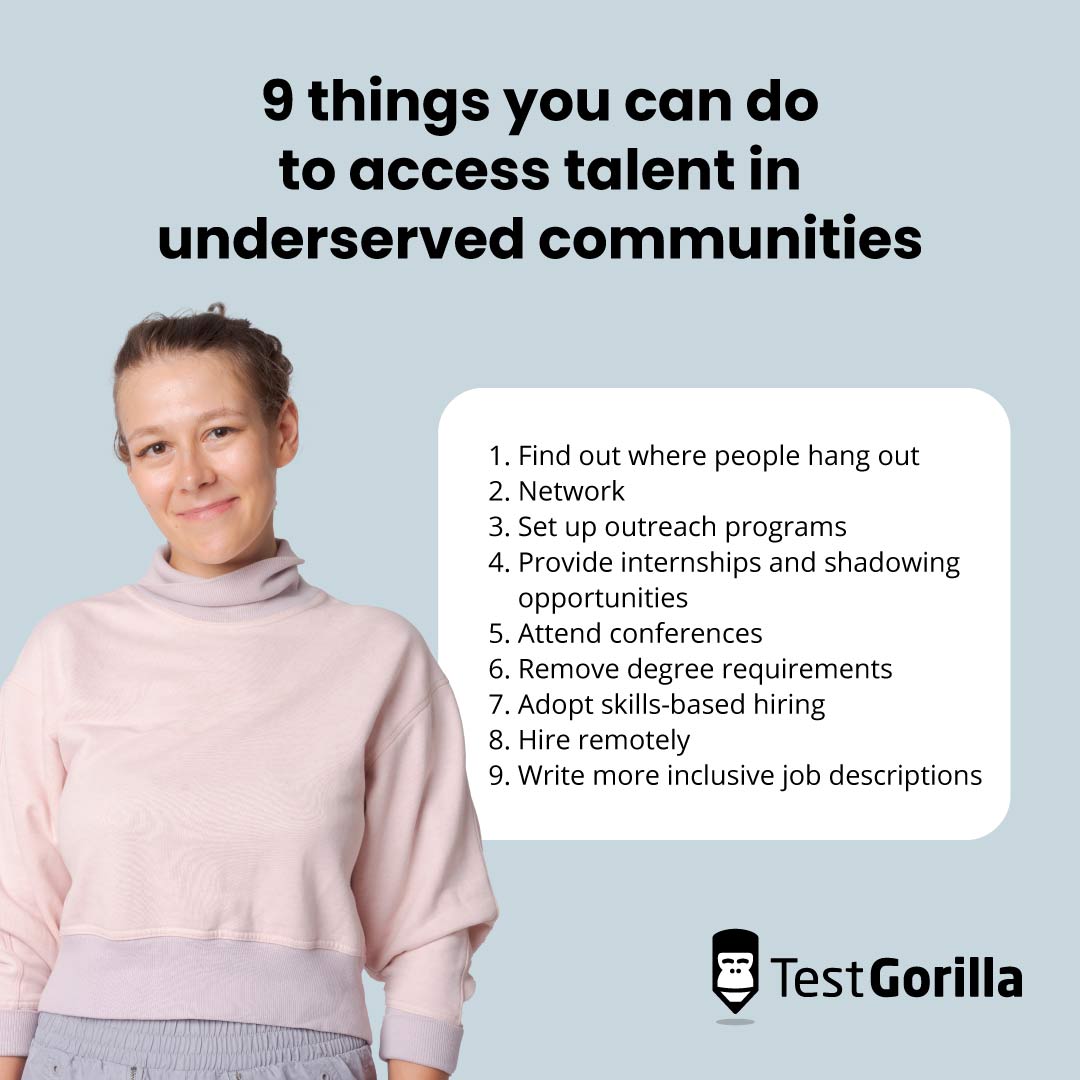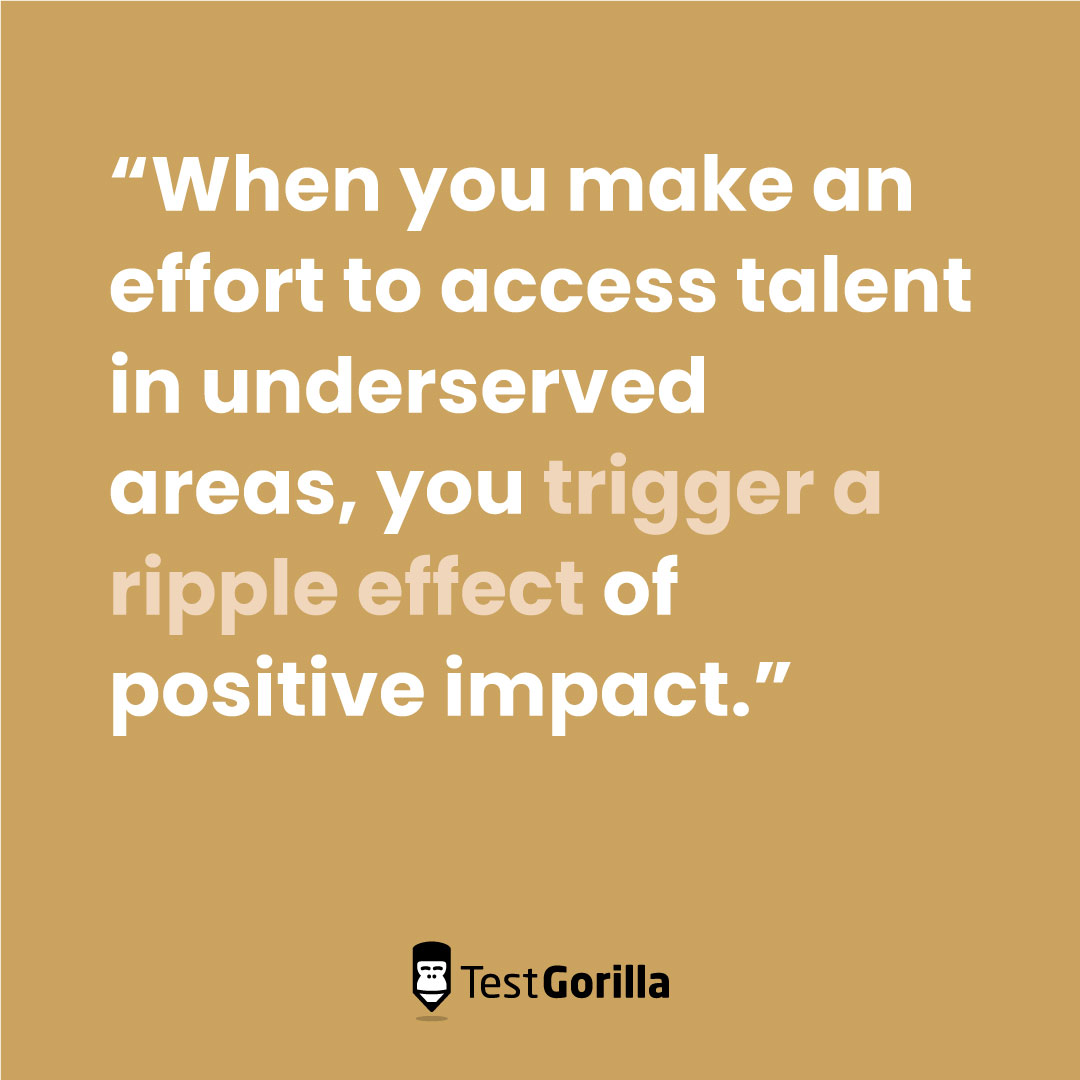With over nine out of ten employers struggling to fill open positions, recruitment can sometimes feel like an uphill struggle.1 You may see your job postings vacant for months, or pour hours into outreach and interviews to no avail.
But maybe the issue is that you’re not looking in the right places for potential candidates.
If you’re ignoring underserved populations in your search for people to fill your roles, you’re missing out on a massive potential talent pool. That means people in areas with limited or no access to resources or groups that are otherwise disadvantaged.
But posting on your go-to job listing sites won’t help you bring people from these communities to your positions.
To do that, you need to rethink your approach to recruitment, outreach, and hiring.
Let’s take a look at the real reason why so many companies are failing to reach underrepresented communities – and explore what you can do to fix that.
Table of contents
People want jobs, and you’ve got job openings. What’s the problem?
The global talent shortage has reached a 16-year high, with 75% of employers struggling to find the right people with the mix of soft and technical skills to fill roles. Additionally, a global talent shortage of more than 85.2 million people is predicted by 2030.
But until the unemployment rate drops to zero, it’s impossible to claim there aren’t enough people to fill open roles.
It’s true that companies across a range of industries, from tech to health care, are engaged in a talent war. Take the healthcare sector, for example. McKinsey estimates that by 2025, there could be an availability gap of between 200,000 and 450,000 available nurses.
So maybe the issue isn’t a lack of potential candidates – but rather that companies aren’t looking for them in the right places.
Much of the time, employers leave out a huge part of the population during their talent search. Because so many businesses fail to reach out to low-income and underserved communities in their recruiting efforts, they’re passing up a huge opportunity to discover a whole new pool of candidates.
Kelly Robinson, the chief executive officer and founder of PKRecruiting, emphasizes that “With a lot of roles, you can learn the skills on the job. It’s just getting the people there.”
Simply sharing your job posting on LinkedIn isn’t going to help you connect with these individuals. According to Kelly, the big issue here is an awareness gap: Most of the time, people in these underserved areas don’t even know these jobs exist.
She explains, “Because of a systematic lack of education, many people in underserved communities just aren’t even sure how to find a job. They have a different thought process when it comes to careers, and they often lack access to technology.”
If candidates aren’t flocking to you, you need to find a way to reach out to them.
What’s being done to connect companies with underserved communities?
There are plenty of public agencies and worker-serving organizations doing their part to give people from underserved communities better career opportunities.
The Mi Casa Resource Center in Denver, Colorado helps educate, train, and support underserved young adults with career development.
Per Scholas is a nonprofit organization with 20 locations across the United States that offers free training in tech careers to folks from marginalized communities.
Both of these organizations partner with businesses to provide pathways to employment.
In the public sector, the Michigan Department of Labor and Economic Opportunity supports the Detroit at Work program, which provides free training to the city’s residents in in-demand fields like construction, skilled trades, healthcare, IT, and manufacturing.
These are just a few examples of worker-serving organizations and public institutions that are helping folks in underserved communities access better employment opportunities. But you’ll find private companies playing a role as well.
How companies are making opportunities more accessible
There are plenty of inspiring examples of companies and communities investing in and connecting with underserved populations.
Jo Webber, PhD, the chief executive officer and founder of AtlasJobs, highlights the Abbott Labs high school internship program as a great example of this. “Recognizing that these kids probably can’t drive and may not have anyone to drive them, Abbott Labs sends a bus around to bring them in, as well as provides them with a shirt for each day of the week.”
Dr. Webber stresses that companies need to make their own opportunities more widely accessible. In her words, “It’s one thing to say ‘Hey, we’ve got all these internships, but only certain kids can get them.’ You need to make it easier to discover them and share these opportunities with diverse populations.”
She highlights the Abbott Labs program as a great example to follow, stating, “They’re really reaching people who otherwise would not have had a chance to work there. And after 10 years of the program, they’re starting to see they hire something like 85% of their interns getting hired at the company.”
Tools like Dr. Webber’s company STEMconnector, or the RiseKit platform, which help connect businesses with potential candidates in underserved communities, are there to help. But you can also take action at your company to proactively hire underrepresented candidates while doing your part to create a more diverse workforce.
The best insights on HR and recruitment, delivered to your inbox.
Biweekly updates. No spam. Unsubscribe any time.
9 things you can do to access talent in underserved communities
If you want to access talent in underserved communities, Kelly Robinson says “You have to go to them.”
Here are 9 ways you can tap into a whole new pool of candidates and create equality of opportunity for underserved communities.
1. Find out where people hang out
While your default may be to post your job listing on LinkedIn, Indeed, or Glassdoor, that’s not going to get you very far if you’re hoping to connect with underserved communities.
Kelly highlights the importance of being open-minded, stating: “There’s a lot of ways to connect with people that would love to work with you but don’t know about your jobs. You need to ask yourself, ‘Where can we find these people? Where do they spend their time both physically and digitally?’”
This could mean advertising your job posting on Instagram or TikTok, or getting in touch with local community groups or churches and asking them to post your listing on their Facebook page. That leads us to our next tip: Networking.
2. Network
Because many residents of underserved communities come from diverse backgrounds and underrepresented groups, connecting with them lets you hire from a more diverse talent pool. This has huge benefits for your teams and company.
In order to do so, you need to get to know their communities. That means networking with community leaders and building relationships with local schools.
Tara Furiani, chief executive officer and host of the Not the HR Lady, shares her expertise: “I have a well-established network of connections with various organizations and community leaders, which allows me to connect with potential candidates and promote job opportunities. Building strong relationships with these communities helps me understand their unique needs and challenges, allowing me to tailor recruitment efforts and create a more inclusive and equitable hiring process.”
Tara notes that “Recruiting from these communities can be more challenging than traditional sources, but the benefits of diversity in the workplace are undeniable.” That’s why you should connect with local organizations and educational institutions and build relationships that help you get to know these communities in a meaningful way.
3. Set up outreach programs
By networking in underserved communities, you get to know community and school leaders, giving you the opportunity to reach out directly to young people and potential candidates. Kelly points out that “People only know whatever they grew up with.” That means if they never met anyone working in your industry, it’s no surprise they aren’t applying for jobs. If they’ve never seen anyone like themselves in that role, it’s hard for them to picture themselves there.
Here’s her suggestion for reaching out to communities and creating programs to help bring individuals to your jobs: “Churches and community centers want to help people find jobs. You can post a flyer on a wall at a church, or ask community leaders to share information on their social media pages. The same goes for unemployment offices – they do a lot of education, so they may allow companies to come in and do training sessions. This lets you get involved in helping that community while reaching folks that need work and could potentially fill a role at your company.”
Develop training programs at community centers and unemployment offices, both on how to search for jobs and about valuable industry-specific information and digital skills. Remember, in this day and age, digital skills are required for just about any role, not just to work in tech, so you can widen participants’ employment possibilities significantly by providing these training sessions.
Plus, running outreach programs helps you increase visibility for your roles as well as provide the knowledge people need to access them.
4. Provide internships and shadowing opportunities
Kelly argues that “Young people need their eyes opened to what their career possibilities are,” and this is doubly true in underserved communities. Throughout your networking, you should be talking to schools and universities to set up internships and shadowing programs.
Kelly recommends you “Go into high schools and colleges, talk to kids, and create opportunities to shadow or intern at your company. By going into the right communities, you’re fostering more equitable access to your industry. It’s really about trying to reach out to schools and educate at a younger age to create more diversity in the workforce in the long run.”
Providing young adults with these opportunities helps level the playing field by giving them access to opportunities they otherwise would be unaware of or wouldn’t have access to. Just be sure to follow the example of Abbott Labs and take steps to make these opportunities accessible for underserved communities. For example, providing transportation or offering paid internships to people putting themselves through college.
5. Attend conferences
Even if you don’t have the resources to build outreach programs in an underserved community, there are still places you can go to reach a more diverse pool of talent. There are a number of industry-specific conferences that aim to help underrepresented groups gain access to jobs and careers.
In the tech world, for example, you’ll find the AfroTech Conference, which promotes diversity in tech, and the ADCOLOR Conference, which advocates for diversity in creative and tech professions. Also, the National Society of Black Engineers puts on the NSBE Annual Convention. This annual event supports and promotes collegiate and pre-collegiate students and technical professionals in engineering and technology.
By attending these events, you’re able to meet a more diverse group of potential candidates. Additionally, you get the chance to network with industry professionals who may have more experience connecting with underserved communities and could give you some guidance on how to do so yourself.
6. Remove degree requirements
Unnecessary degree requirements exclude underrepresented groups from accessing your roles.
Scott Lieberman, the chief operating officer at The Rideshare Guy, a resource for gig workers, suggests that: “If you require a university degree for a job that doesn’t actually need one, you’re often excluding a greater percentage of applicants of certain races, as well as folks of all backgrounds who didn’t have access to money or couldn’t afford to take on the debt needed to get that degree.”
To prevent that from happening, take degree requirements out of job postings when possible.
In your job listing, place a greater emphasis on culture add, candidate experience, and transferable skills. There are many workers that would be able to transition from their current job into other roles and industries if given the chance, and degree requirements can be a serious hindrance to that possibility.
7. Adopt skills-based hiring
You need to take things a step further than removing degree requirements to access talent in underserved communities. Taking the emphasis off the traditional resume and adopting skills-based hiring reduces the probability of bias creeping into your recruitment process.
Resumes generate significant bias, yet we rely on them for hiring, so marginalized communities are perpetually at a disadvantage… We need to quit putting so many requirements into job descriptions and focus more on solving the problem: ‘What can this person do?’ Not, ‘what have they done and where?
Katherine McCord, president and entrepreneur at Titan ATS
Skills-based hiring is a proven way to increase diversity in the workforce: According to our 2022 State of Skills-Based Hiring report, this approach to hiring has a 91.1% success rate when it comes to increasing workplace diversity.
By focusing on skills rather than resumes and degrees, you also increase your chances of making better hiring decisions: 91.2% of the companies we surveyed saw an increase in employee retention after adopting skills-based hiring.
8. Hire remotely
Believe it or not, removing location requirements is also an effective way to access talent in underserved communities. That’s why offering the option of remote work can help you widen your talent pool and create more equal opportunities.
Scott Lieberman emphasizes that “If you require workers to be in your office when they don’t actually need to be, you’re excluding people who can’t afford to live within commuting distance of your business, and you may be disqualifying candidates who live in rural or underserved areas. That means you end up catering to racial groups who live within commuting distance of your office, as well as folks who can afford to pay for child care.”
While not all jobs can be remote, there are still plenty of positions that are listed as in-person that could easily be transformed into remote or hybrid roles. Consider this when creating your job listings, and think about modifying your role requirements if you want to reach more candidates than those who live near where your office is located.
9. Write more inclusive job descriptions
Be conscious of how you word your job descriptions in your listings. Avoid using gendered and ableist language and steer clear of cultural and racial biases when writing job descriptions.
No more gendered words like “rock star” or “ninja.” Instead, replace them with accurate descriptions of the role you’re filling.
You should also avoid using the term “native speaker” or mentioning race or national origin. Ditto industry jargon or corporate language, which can discourage candidates who are younger or newer to the industry from applying.
Finally, outline your benefits, schedule flexibility, and salary range in your job posting. Many candidates from underserved communities who may be caregivers or from low-income households will prioritize access to benefits like healthcare and flexible working hours. Posting transparent salary ranges also builds trust and reassures candidates that it’s worth their time applying for your position.
Engage with untapped talent from underserved communities to improve workplace diversity
When you neglect talent in underserved communities, you’re missing out on the opportunity to discover people that can bring diverse, unique perspectives and skills to your organization. But by engaging with these communities and modifying your hiring practices, you can reach these untapped pools of potential candidates.
When you make an effort to access talent in underserved areas, you trigger a ripple effect of positive impact.
Not only do you create job opportunities for people who would otherwise lack access to them, but you begin to create visibility and expectations about what types of careers are available to them. Especially for young folks or those from minority groups or marginalized communities who would otherwise be unaware of these possibilities.
Though it requires more effort than simply uploading a job posting to LinkedIn, taking the time to interact and connect with underrepresented groups benefits everyone in the long run: Both the community at large and your business.
In Kelly Robinson’s words, “When you elevate a community, you help everyone in the community.”
Reach wider talent pools and create more equal job opportunities. Discover how adopting a skills-based approach to hiring can help you build a more diverse, inclusive workplace. Download the 2022 State of Skills-Based Hiring report to learn more.
You've scrolled this far
Why not try TestGorilla for free, and see what happens when you put skills first.

















